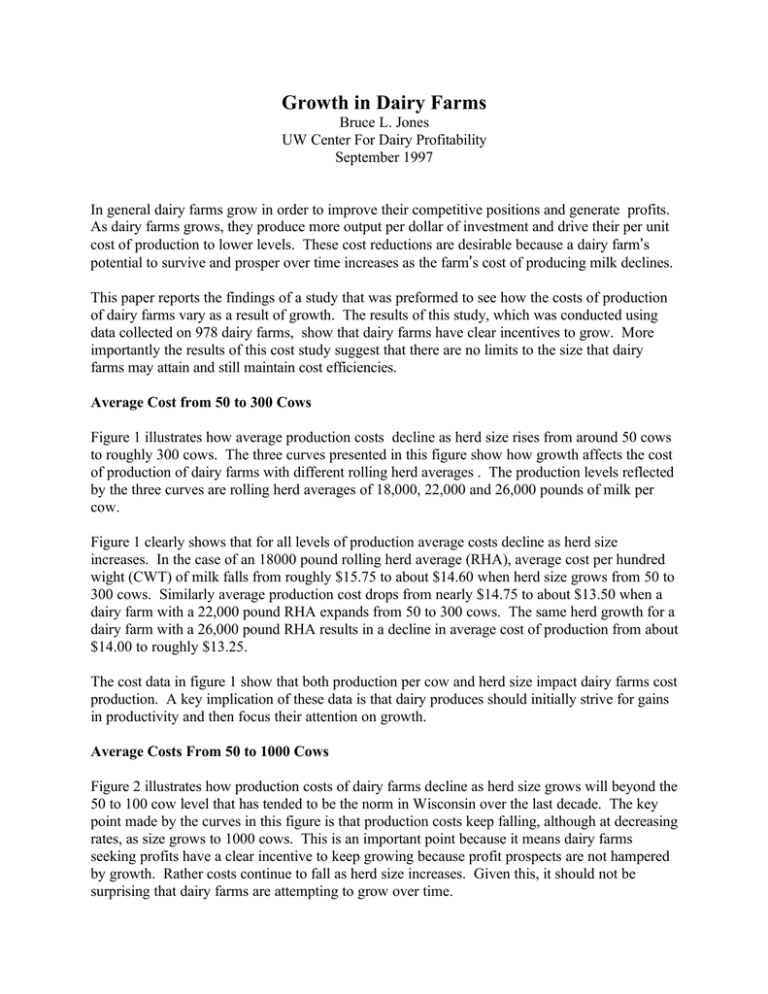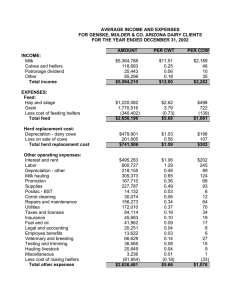Growth in Dairy Farms
advertisement

Growth in Dairy Farms Bruce L. Jones UW Center For Dairy Profitability September 1997 In general dairy farms grow in order to improve their competitive positions and generate profits. As dairy farms grows, they produce more output per dollar of investment and drive their per unit cost of production to lower levels. These cost reductions are desirable because a dairy farm s potential to survive and prosper over time increases as the farm s cost of producing milk declines. This paper reports the findings of a study that was preformed to see how the costs of production of dairy farms vary as a result of growth. The results of this study, which was conducted using data collected on 978 dairy farms, show that dairy farms have clear incentives to grow. More importantly the results of this cost study suggest that there are no limits to the size that dairy farms may attain and still maintain cost efficiencies. Average Cost from 50 to 300 Cows Figure 1 illustrates how average production costs decline as herd size rises from around 50 cows to roughly 300 cows. The three curves presented in this figure show how growth affects the cost of production of dairy farms with different rolling herd averages . The production levels reflected by the three curves are rolling herd averages of 18,000, 22,000 and 26,000 pounds of milk per cow. Figure 1 clearly shows that for all levels of production average costs decline as herd size increases. In the case of an 18000 pound rolling herd average (RHA), average cost per hundred wight (CWT) of milk falls from roughly $15.75 to about $14.60 when herd size grows from 50 to 300 cows. Similarly average production cost drops from nearly $14.75 to about $13.50 when a dairy farm with a 22,000 pound RHA expands from 50 to 300 cows. The same herd growth for a dairy farm with a 26,000 pound RHA results in a decline in average cost of production from about $14.00 to roughly $13.25. The cost data in figure 1 show that both production per cow and herd size impact dairy farms cost production. A key implication of these data is that dairy produces should initially strive for gains in productivity and then focus their attention on growth. Average Costs From 50 to 1000 Cows Figure 2 illustrates how production costs of dairy farms decline as herd size grows will beyond the 50 to 100 cow level that has tended to be the norm in Wisconsin over the last decade. The key point made by the curves in this figure is that production costs keep falling, although at decreasing rates, as size grows to 1000 cows. This is an important point because it means dairy farms seeking profits have a clear incentive to keep growing because profit prospects are not hampered by growth. Rather costs continue to fall as herd size increases. Given this, it should not be surprising that dairy farms are attempting to grow over time. Figure 1: COSTS FROM 50 TO 300 COWS Figure 2 : COSTS FROM 50 TO 1000 COWS Appendix: Cost Per Hundredweight Equivalent As A Function Of Herd Size And Average Milk Production Per Cow COST/ CWT. EQUIV = 31.94424 + [ 8.183738 ( 2.246239 ) ( 2.497371 ) HERD -.5 ] + [ .0000000344 ( .00000000438 ) 2 MILK/COW ] - [ .00164 MILK/COW ] ( .000157) Where: COST/ CWT. EQUIV is the cost per hundredweight equivalent of milk; HERD, the size of the milking herd in terms of milk cows; MILK/COW, the average annual production of milk for each cow in the herd; and the values in parentheses are the standard errors for each of the estimated coefficients. 2 The R statistic for the above model, which was estimated using ordinary least squares regression techniques, is .318755.





